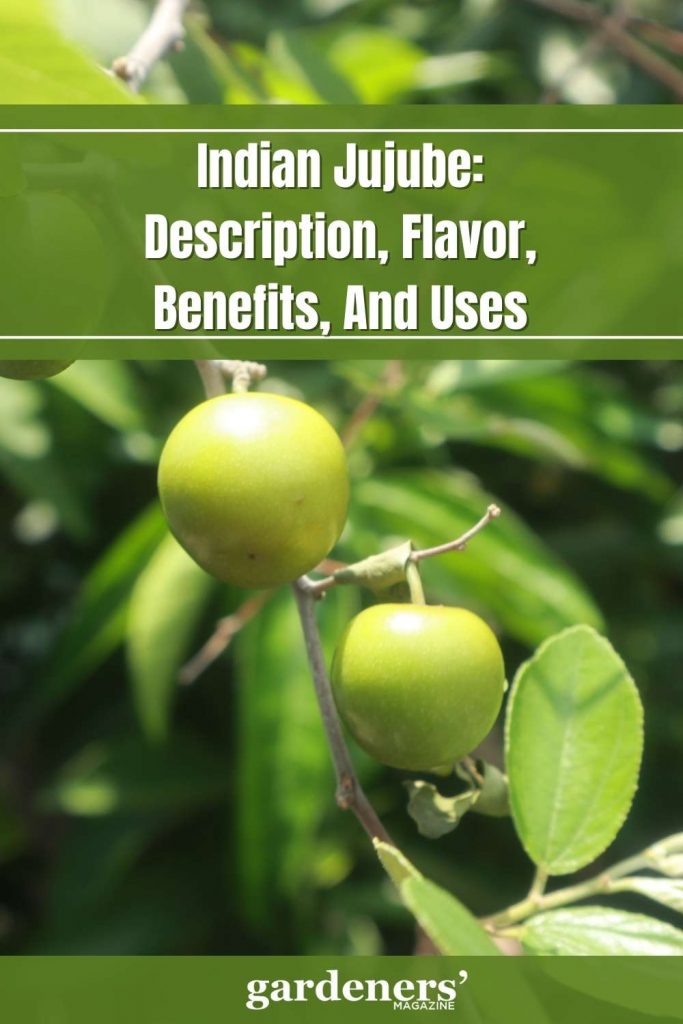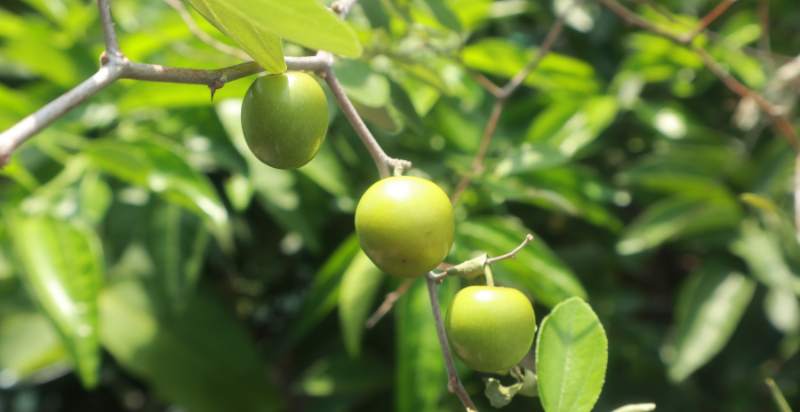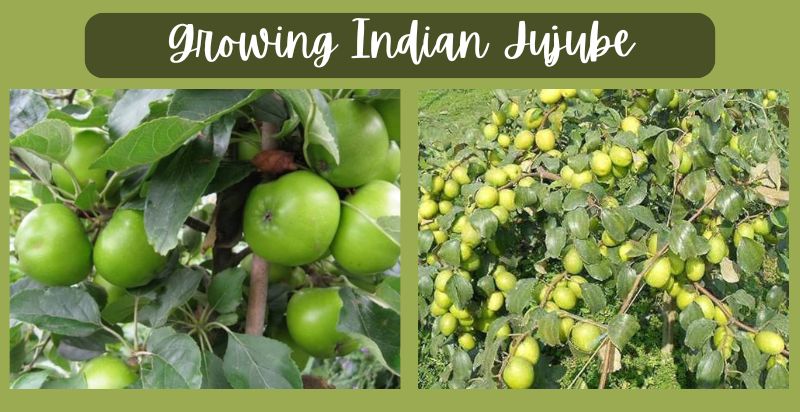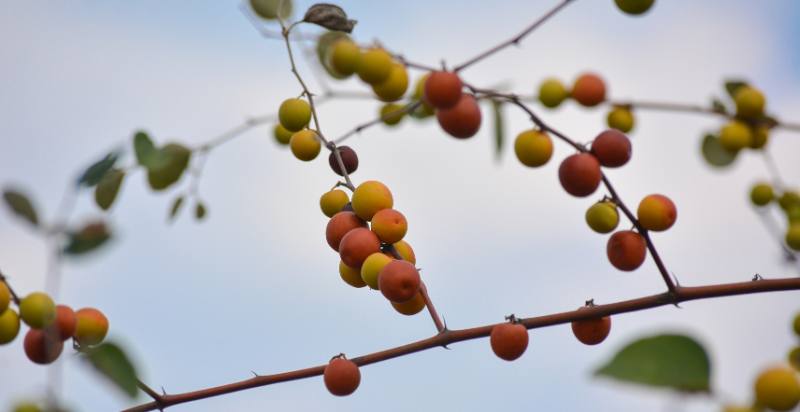Welcome to the world of Indian Jujube, a delightful member of the Rhamnaceae family that enchants both gardeners and botanists alike. Known scientifically as Ziziphus mauritiana, this small deciduous tree bears fruits that are cherished for their sweet, crisp flesh and nutritional value. Originating from South Asia, particularly India, this species has been cultivated for centuries, weaving its way into cultural traditions and culinary delights across the region. With its glossy green foliage, gnarled branches, and petite yellowish-green fruits, the Indian Jujube adds both aesthetic charm and practical utility to any garden landscape. Join me on a journey to explore the botanical wonders and cultural significance of this remarkable tree.

What is Indian Jujube, and Why is it so Popular?
Indian Jujube is a small deciduous tree native to South Asia, particularly India. Its popularity arises from its delicious and nutritious fruits, prized for their sweet flavor and rich vitamin content, especially vitamin C. The tree’s adaptability to diverse climates, including arid regions, makes it widely cultivated. Beyond its culinary appeal, it holds cultural significance, often featuring in festivals and traditional ceremonies.
Moreover, various parts of the tree have been used in traditional medicine for their purported health benefits, ranging from aiding digestion to promoting sleep. This multiplicity of virtues—culinary, cultural, and medicinal—has cemented the Indian Jujube’s status as a beloved fruit tree in the regions where it is grown, offering not just sustenance but also a connection to tradition and well-being.
Additionally, jujubes are versatile as they can be eaten fresh, dried, or cooked.

History and Origin of the Indian Jujube:
Historical records and archaeological evidence suggest that Indian Jujube has been cultivated since ancient times, with mentions in ancient texts such as the Vedas and the Mahabharata. Its significance in Indian culture is evident through its association with festivals, religious rituals, and traditional medicine practices.
Over the centuries, Indian Jujube has spread to various parts of Asia, Africa, and beyond, carried by traders, explorers, and migrants. Its adaptability to different climates and soil conditions has contributed to its widespread cultivation in regions with similar ecological characteristics.
Today, Indian Jujube remains an integral part of agricultural landscapes in South Asia and is celebrated for its delicious fruits, cultural significance, and medicinal properties. It embodies a legacy of tradition and sustenance passed down through generations.
How to Grow Indian Jujube?
Growing Indian Jujube requires attention to specific conditions and techniques:
- Climate and Soil: Indian Jujube thrives in warm climates with full sun exposure. It can tolerate a variety of soil types but prefers well-drained, sandy, or loamy soil with a pH between 6.5 and 8.0.
- Propagation: Indian Jujube can be propagated from seeds, cuttings, or grafting. Seeds should be scarified and soaked in water for 24 hours before planting to improve germination rates. Cuttings should be taken from semi-hardwood branches and rooted in a suitable growing medium.
- Planting: Plant Indian Jujube trees in spring after the danger of frost has passed. Choose a sunny location with adequate space for the tree to grow, typically 15 to 20 feet apart. Dig a hole twice the size of the root ball and backfill with a mixture of compost and soil.
- Watering: Indian Jujube trees require regular watering, especially during the first few years of growth. Once established, they are drought-tolerant but benefit from occasional deep watering during dry periods.
- Fertilization: In early spring, fertilize Indian Jujube trees with a balanced fertilizer before new growth begins. Avoid excessive nitrogen, as it can promote vegetative growth at the expense of fruit production.
- Pruning: Prune Indian Jujube trees to maintain shape, remove dead or diseased branches, and encourage fruit production. Pruning is typically done in late winter or early spring before new growth emerges.
- Pest and Disease Management: Indian Jujube trees are relatively resistant to pests and diseases. However, occasional pest infestations or diseases such as root rot may occur. Monitor trees regularly and treat any issues promptly with appropriate measures.

Where is Indian Jujube grown?
Indian Jujube is primarily grown and harvested in regions across South Asia, particularly in countries such as India, Pakistan, Bangladesh, and Sri Lanka. Within these countries, it is cultivated in a variety of climatic conditions, ranging from tropical to subtropical regions.
In India, Indian Jujube is cultivated extensively in states such as Gujarat, Maharashtra, Uttar Pradesh, Rajasthan, Punjab, and Karnataka. In Pakistan, it is grown in provinces like Punjab, Sindh, and Balochistan. Similarly, in Bangladesh and Sri Lanka, it is cultivated in various regions with suitable climatic conditions.
In the United States, Indian Jujube, also known as Chinese date or simply Jujube, is primarily grown and harvested in regions with warm climates, particularly in the southern states. California is one of the main areas of cultivation, especially in the Central Valley region, where the climate is suitable for its growth.
Other states where Indian Jujube is grown include Texas, Arizona, Florida, and parts of the Gulf Coast region. These areas provide the necessary conditions for Indian jujube trees to thrive, with long, hot summers and mild winters. The fruit is typically harvested in late summer to early fall when it reaches maturity and attains its desired flavor and texture.
Nutritional Content of Indian Jujube:
Indian Jujube boasts a rich nutritional profile. In every 100 grams, it offers approximately 79 calories and is predominantly composed of carbohydrates, including dietary fiber. Notably, it is abundant in vitamin C, providing over 100% of the recommended daily intake, essential for immune function and skin health.
Additionally, Indian Jujube contains minerals like potassium, calcium, phosphorus, and iron, vital for heart health, bone strength, and preventing anemia. Rich in antioxidants such as flavonoids and carotenoids, it combats harmful free radicals, promoting overall health and well-being.
Health Benefits of Indian Jujube:
It offers a myriad of health benefits. Rich in vitamin C, it boosts immunity and aids in fighting off infections. Its dietary fiber content supports digestive health by promoting gut health and preventing constipation. Potassium regulates blood pressure, contributing to heart health, while calcium and phosphorus strengthen bones and prevent osteoporosis. The fruit’s iron content helps prevent anemia and improves energy levels.
Additionally, Indian Jujube’s antioxidant properties combat oxidative stress, reducing the risk of chronic diseases like cancer and cardiovascular disorders. Incorporating Indian Jujube into your diet can enhance overall health and well-being.
Flavor Profile of the Indian Jujube:
The flavor profile of Indian Jujube is a delightful combination of sweetness with subtle tartness. The ripe fruits offer a rich, honey-like sweetness that is balanced by a hint of tanginess, creating a refreshing taste sensation. The flesh is crisp and juicy, with a texture reminiscent of crisp apples or pears. Some varieties may have a slightly floral or musky aroma, adding complexity to the overall flavor experience.
Indian Jujube fruits are often enjoyed fresh, where their sweet and tangy flavor shines, but they can also be dried or used in various culinary preparations, including jams, preserves, and desserts. Overall, the flavor of Indian Jujube is both delicious and distinctive, making it a cherished fruit in culinary traditions across South Asia and beyond.
Harvesting Indian Jujube:
Harvesting Indian Jujube requires attention to ripeness and gentle handling. Fruits are best picked when fully ripe, indicated by a uniform color, slight softness, and sweet aroma.
A fully ripened Indian Jujube fruit typically has a deep yellowish-green to reddish-brown color with a uniform appearance. When gently squeezed, it yields slightly, indicating juiciness. The fruit emits a sweet, fruity aroma, particularly noticeable near the stem. Fully ripe fruits are plump and rounded, without any signs of shriveling or wrinkling. Timing varies but generally occurs from late summer to early autumn.
Harvesting can be done by hand or gently shaking the tree. After harvest, remove damaged fruits and wash them gently. Indian Jujube can be stored in the refrigerator for short periods or dried for long-term storage. Careful harvesting ensures fruits are enjoyed at their peak flavor and quality.

How to Store Indian Jujube?
Indian Jujube can be stored in the refrigerator for up to two weeks. Place them in a perforated plastic bag or container with ventilation holes to maintain optimal humidity. Alternatively, if you plan to consume them within a few days, store them at room temperature in a cool, dry place away from direct sunlight. For long-term storage, Indian Jujube can be dried. Wash and dry the fruits thoroughly, then air dry them for several days until leathery in texture. Store dried Indian Jujube in an airtight container in a cool, dark place for several months to a year.
Where to find the Best Quality Indian Jujube?
To find the best quality Indian Jujube in the U.S., consider exploring local farmers’ markets during the harvest season. These markets often offer fresh, locally grown produce directly from farmers who prioritize quality.
Additionally, Asian grocery stores, particularly those serving South Asian communities, may carry Indian Jujube, either fresh or dried. Specialty produce markets and online retailers specializing in exotic fruits are other potential sources.
When selecting Indian Jujube, look for plump, firm, and free from blemishes fruits with a vibrant color and sweet aroma indicating ripeness.

Culinary uses of Indian Jujube:
Indian Jujube pairs well with a variety of fruits and vegetables in both sweet and savory dishes. Here are some ideas for combining Indian Jujube with other ingredients:
- Fruit Salads: Mix Indian Jujube with other seasonal fruits like apples, pears, grapes, and citrus fruits to create a refreshing fruit salad. For extra flavor, add a squeeze of lemon juice and a sprinkle of fresh mint.
- Smoothies: Blend Indian Jujube with bananas, berries, spinach, or kale for a nutritious and delicious smoothie. For creaminess, add yogurt, almond milk, or coconut water.
- Baked Goods: Incorporate chopped Indian Jujube into muffins, bread, cakes, or cookies for added sweetness and texture. They pair well with nuts, oats, and spices like cinnamon and nutmeg.
- Chutneys and Salsas: Combine Indian Jujube with other fruits like mangoes, pineapples, or tomatoes to make chutneys or salsas. These versatile condiments can be served alongside grilled meats and fish or as a topping for tacos and sandwiches.
- Savory Salads: Add Indian Jujube to savory salads made with greens like spinach, arugula, or mixed greens. Combine with ingredients like feta cheese, nuts, seeds, and a tangy vinaigrette for a flavorful salad.
- Stir-Fries and Curries: Indian Jujube, along with vegetables like bell peppers, onions, carrots, and broccoli, can be included in stir-fries, curries, and rice dishes. The sweet and tangy flavor of jujube adds depth to these savory dishes.
- Pickles and Preserves: Use Indian Jujube to make pickles or preserves with other fruits and vegetables. Combine with ingredients like ginger, garlic, chili peppers, and vinegar for a tangy and spicy condiment.

By combining Indian Jujube with other fruits and vegetables, you can create a wide range of dishes that highlight its unique flavor and texture. Experiment with different flavor pairings to discover your favorite combinations.
Conclusion:
In a nutshell, Indian Jujube is your culinary sidekick, ready to jazz up any dish with its sweet and tangy goodness. Whether you’re tossing it in a fruit salad, blending it into a smoothie, or adding it to a savory stir-fry, this little fruit packs a flavorful punch. Plus, it’s not just tasty – it’s also jam-packed with nutrients! So, next time you’re in the kitchen, don’t forget to invite Indian Jujube along for the ride. Trust me, your taste buds will thank you!
- Wood Mulch: Everything You Should Know & More… - January 17, 2025
- Cosmic Purple Carrot: Description, Origins, Uses & More… - December 24, 2024
- Black Sapote: Description, Origins, Uses & More… - December 24, 2024

1 thought on “Indian Jujube: Description, Flavor, Benefits, And Uses”
Comments are closed.